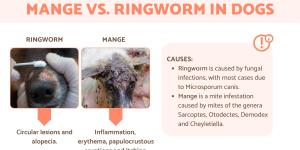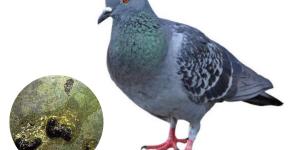Animal infectious diseases
Learn more about animal infectious diseases by exploring our site and become a true expert on the animal kingdom. You'll find content created for the best professionals with pictures, videos and opinions.
39 articles

Can a cat with leukemia be around other cats? If you have a cat diagnosed with Feline Leukemia Virus (FeLV), you might be wondering whether they can safely interact with other felines. FeLV is a contagious disease that weakens a cat’s immune system, making them more vulnerable to infections. Understanding...

Otitis is the scientific term for an ear infection, although it most specifically refers to general inflammation of the ear. This can also be caused by non-infectious processes such as fluid buildup. It can affect the external, middle or inner parts of the ear, potentially causing serious discomfort in...

Ringworm and mange are common skin conditions in dogs which are often confused with each other. While both will result in deterioration of the skin and have some similar symptoms, they are very different in terms of pathogenesis. With such differences in causes and symptoms, treatment of mange and ringworm...

Abscesses in cats are painful accumulations of pus that result from bacterial infections. When an abscess forms, the body encapsulates the pus in connective tissue to contain the infection and prevent it from spreading. However, if bacteria or microorganisms escape into the bloodstream, it can pose a serious...

Anal sacculitis is a condition affecting dogs that occurs when the anal glands become obstructed or infected. This can lead to discomfort, pain, and difficulty defecating. While anal sacculitis can be uncomfortable for dogs, it's usually treatable with proper veterinary care. If you notice your dog exhibiting...

Fever in dogs is a symptom of various diseases, whether relatively mild or life threatening. It is part of the dog's immune response, resulting a significant increase in the dog's internal body temperature. The response of the immune system is provoked by various medical conditions, such as infections and...

It might take a while for us to notice a sore mouth in our dog. Generally speaking, dogs are good at hiding their pain. The cause of their sore mouth may have originated a long time before we observe any symptoms. If we see the dog pawing their face or refusing to eat due to the discomfort present in their...

Avian colibacillosis, often shortened to colibacillosis or E. coli disease, might sound familiar, but it's far more complex than your typical E. coli. This widespread infection impacts a vast array of birds, from backyard pets to poultry farms and even wild creatures. Beyond economic losses, the disease...

Equine Influenza is a contagious and common respiratory disease that affects horses worldwide. This informative resource aims to shed light on the symptoms and various treatment approaches for this concerning ailment, equipping horse owners, caregivers, and enthusiasts with essential knowledge to safeguard...

Cattle are susceptible to many diseases that can cause significant economic losses to farmers and are also considered a serious problem with the potential to affect public health. Many of these diseases are also zoonotic diseases, i.e., diseases that can affect humans if their meat or milk is consumed....

Sheep diseases are an important aspect to take into account when raising these animals. Like any other living being, sheep are susceptible to various diseases that can affect their health and wellbeing. These diseases can be caused by bacteria, viruses, parasites or other infectious agents. Some diseases...

Salmonellosis in pigeons, also known as paratyphosis, is an infection caused by the bacterium Salmonella typhimurium. This particular disease primarily affects pigeons that are immunocompromised, often leading to a variable clinical presentation depending on the affected organ. It is important to note...

Tetanus is a neurological disease caused by a neurotoxin. It is caused in dogs by a bacterial infection that begins in the animal's body through an open wound. The toxin attacks the nerves, spinal cord and brain, causing muscle spasms in the animal. Contrary to popular belief, tetanus is not found exclusively...

In October 2022, a virus was reported to be emerging among local pigeon populations of the United Kingdom. It was particularly notable for its symptoms which appeared to turn the pigeons into zombies. These headlines alarmed many readers, leading to various questions about its symptoms, contagion and other...

Although a dog's paws are protected by a layer of keratinized tissue, it is still possible for them to develop a fungal infection. In fact, due to the greater contact a dog's feet have with various surfaces, they are one of the body parts which are most commonly exposed to fungus. Ringworm and yeast...

Avian infectious coryza is an upper respiratory tract infection caused by Avibacterium paragallinarum. The disease affects only chickens, especially laying hens and occasionally broilers. Reports of quail and pheasants probably describe a similar disease caused by a different bacterium. At first glance it appears...

Ringworm is a fungal skin infection that causes alopecic lesions with scaling and redness, usually starting on the head and later spreading to other parts of the body. Diagnosis and treatment are simple, but since it is a zoonotic disease, it must be treated carefully to prevent transmission to humans.
In...

Cockroaches are arthropods which are capable of transmitting diseases. Unlike ticks and mosquitoes, which transmit pathogens directly through their bites, cockroaches spread diseases indirectly due to their unhygienic habits. They contaminate surfaces with bacteria, viruses, fungi and parasites which...

When we see our dog is having trouble urinating, it is common for many dog guardians to ask can my dog get a UTI (urinary tract infection)? Dogs can indeed suffer from UTIs and do so in a similar way to humans. In fact, urinary and bladder infections in dogs are relatively common. Both male and female...

Feline Malassezia dermatitis occurs as a secondary effect of some pathological diseases, but can also be due to immunosuppressives, alterations to the skin or certain environmental conditions. This is a yeast-type fungus which occurs naturally as commensal flora in the skin and ear canals of cats. It also...

Feline cryptococcosis is the most common systemic fungal disease in cats. However, its infection incidence in the feline population is low, a seeming contradiction we will explain further. Cryptococcus fungi most frequently affect the nasal area, often resulting in an inflamed nose. Swelling of the...

Osteomyelitis in dogs is the inflammation of the bone due to a bacterial or fungal infection. This painful disease will need professional intervention as soon as possible as the treatment takes several weeks to various months, depending on the type of osteomyelitis and its severity.
In this AnimalWised article...

Metritis is something which can only happen to female dogs. This is because it is an infection of the uterus. A bacterial infection, it occurs during birthing or shortly thereafter. There are different causes of metritis, as we will see further on in this AnimalWised article. While we should be ensuring...

Bacteria are single-celled microscopic organisms that live in the environment, on the skin, in a respiratory tract and/or digestive and urinary tract of animals and people. Some bacteria are capable of causing diseases and reaching the blood, but this is normally done so in a small number and can be killed...

Rabies is a disease that can affect all mammals, including humans. Although rabies is not a very common in cats, it is very dangerous, since it has no cure and results in the death of an animal. Does your cat often leave the house and is in contact with other animals? If so, rabies prevention is key!
For...

If a cat is leaking brown fluid form their anus, it is most likely due to their anal glands. Although it will be coming from the anal area, it could be from these glands located just next to the anus itself. These anal glands serve very important purposes, including aiding in defecation and scent recognition....

Rabies is generally associated with dogs. We may fear stray dogs in case they are rabid, especially if they seem aggressive, but the same fear rarely occurs when encountering cats. However, in a 2008 study by the American CDC (Center for Disease Control and Prevention), it was shown that more rabies cases...

Anemia is not a disease in itself, but a blood disorder which often results from disease, as well as other causes. It describes the condition of low red blood cells and/or low hemoglobin in the dog's blood. There are several types of anemia, each with its particular characteristics and respective treatments....

The normal body temperature in cats fluctuates between 38ºC and 39.5ºC (100.4ºF and 103.1ºF). When the internal body temperature of a cat exceeds this top parameter they have a fever. A cat will have a fever due to their health being impaired, usually due to their body fighting an infection of some sort....

While it is an invasive procedure, spaying your dog has a range of benefits. Their lack of ability to become pregnant prohibits the birth of puppies we don't have the resources to care for and thus reducing the cases of abandoned pets which need shelter care. Neutering also helps with their psychological...

Dogs are a type of mammal, a group of animals distinguished by having mammary glands. These glands are used by females to feed their young. For this reason, it is common for a swollen dog nipple to occur before, during or after lactation because the breasts are engorged with milk. They can even become...

Blood in a dog's urine can be a worrying sign. It's called hematuria and is usually a symptom that your dog's health is impaired, possibly seriously. The most common causes can range from urinary tract infections (UTIs) to tumors, kidney stones to infectious diseases like parvovirus. Therefore, if you see drops...

Feline infectious rhinotracheitis is a very serious and highly contagious disease that affects a cat's respiratory system. This infection is caused by the Herpesvirus Feline 1 (HVF-1) virus and generally affects cats with a low immunity.
When the infection is acute, the prognosis is rather reserved....

Perianal fistulas in cats are a medical condition characterized by the formation of abnormal tunnels or tracts around the anal region. These fistulas can be quite painful and are often associated with other underlying health issues. While the exact prevalence of perianal fistulas in cats is not well-documented,...

Our dogs' ears are very sensitive to lesions. An otitis can cause our pet to go through a very important decay and anorexia due to pain and discomfort.
Otitis externa can cause a perforated eardrum due to secretion and inflammation of the ear canal. The medical treatment varies according to whether...

If you have a cat, you will know that these pets are very special. To take care of your faithful companion it is important that you know which diseases they can suffer from. AIDS in cats is one of the diseases, along with feline leukemia, that is greatly affecting the cat population. However, even if you...

Black and brown bats are dangerous to humans and pets, because everything from their droppings to their bite is infectious and can lead to diseases. Although it is rare to be attacked by a bat, when it happens you'll notice their very small but razor-sharp teeth. After being bitten by a bat, there is a risk...

Toxoplasmosis is an infectious disease that can affect cats as well as dogs. The disease can be worrying if the cat's owner is pregnant; although it's difficult, the disease might be transmitted to the fetus. If someone at home is pregnant and you suspect your cat has toxoplasmosis, go to the doctor and the...

Canine mastitis is one of the most common conditions that affect nursing dogs or dogs that have recently given birth; it can even occur in female dogs that are not pregnant. For this reason, if a bitch is a member of our family it is important to know the symptoms that it can cause and the treatments that...
